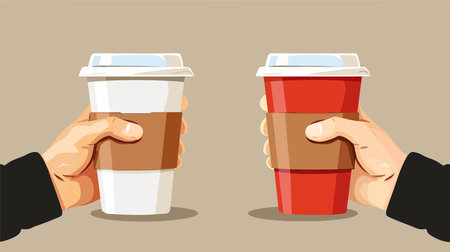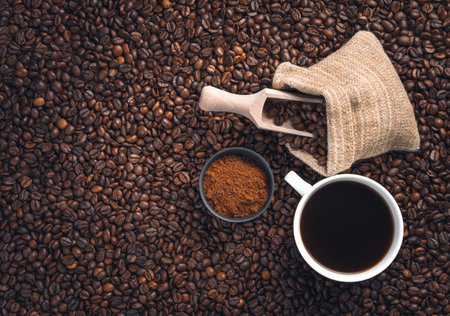Understanding Carbon Footprints in the British Coffee Scene
To truly appreciate the carbon footprint of coffee packaging, we must first unravel what a carbon footprint actually entails—especially against the backdrop of the UK’s spirited coffee culture. Whether you’re weaving through London’s labyrinthine lanes, seeking that perfect flat white in an independent café, or grabbing a quick Americano at a well-known chain on your way to work, every cup has a hidden cost beyond the price tag. In Britain, where coffee rituals have become as cherished as afternoon tea, this impact isn’t just about the beans; it’s about everything that wraps, seals, and delivers them into our hands. A carbon footprint essentially measures the total greenhouse gas emissions caused directly or indirectly by an individual, event, organisation, or product throughout its lifecycle. When it comes to coffee packaging in the UK, this means tracking emissions from materials sourced—whether it’s ethically harvested kraft paper or petroleum-based plastics—to manufacturing processes humming away in warehouses from Manchester to Milton Keynes, right up to the moment you bin (or hopefully recycle) that empty bag. As our high streets pulse with new-wave roasters and classic chains alike, each committed to their own vision of sustainability, understanding this invisible trail of emissions is crucial. In essence, it invites us to look beyond what meets the eye—the aroma and artistry—and consider how every element of packaging contributes to our collective environmental legacy across Britain’s caffeinated landscape.
2. From Bean to Bag: The Carbon Impact of Coffee Packaging
When we cradle that warming cup of coffee on a drizzly morning, it’s easy to forget the intricate journey taken by the packaging alone—an odyssey with a carbon shadow stretching from origin to recycling bin. In the UK, where sustainability is climbing the agenda and local roasteries are popping up alongside historic high streets, unpacking (pun intended) the true carbon cost of coffee packaging is vital. Let’s trace the story from bean to bag, mapping out where emissions sneak into the process and how mindful choices can curb their footprint.
The Life Cycle of Coffee Packaging
Every stage in the life cycle of a humble coffee bag has its own carbon tale. Here’s a breakdown:
| Stage | Key Activities | Carbon Emission Hotspots |
|---|---|---|
| Raw Material Sourcing | Sourcing paper, plastic, aluminium, or compostable materials | Extraction, deforestation, transportation from global suppliers |
| Manufacturing & Processing | Forming films, laminating layers, producing valves & zips | Energy use (often fossil fuels), waste generation, chemical processing |
| Packing & Filling | Packing roasted beans at origin or in the UK; sealing bags | Machinery energy consumption; transportation if packaging is imported separately |
| Distribution & Retail | Shipping to cafés, shops, and homes across Britain | Lorry emissions, refrigerated storage for freshness, “last mile” delivery footprint |
| End-of-Life Disposal | Recycling, landfill, incineration or composting schemes in the UK | Methane from landfill if not recycled; energy use in recycling processes; contamination risks for compostables |
Where Do Emissions Sneak In?
The devil is in the details—and often in the distance travelled. Materials like aluminium offer airtight protection but carry a heavy carbon burden due to mining and refining. Imported packaging may clock up more miles than your average city cyclist. Energy-hungry manufacturing processes and non-renewable power sources add another layer of emissions. Even after serving its purpose, if a bag ends up in landfill rather than being properly recycled or composted (a common fate given UK recycling inconsistencies), its environmental debt lingers.
A Local Lens: The UK Perspective
For British coffee producers and aficionados alike, local sourcing of both beans and packaging materials can drastically reduce supply chain miles. With many towns now home to micro-roasteries and eco-conscious independent cafés, there’s growing interest in UK-made packaging—think recycled paper bags printed with water-based inks or innovative plant-based bioplastics that fit local composting systems. However, these alternatives must still be measured against durability needs (rainy British weather isn’t kind to paper!) and accessibility for end-of-life disposal infrastructure.

3. Packaging Choices: Biodegradable, Recyclable, or Reusable?
If you’ve wandered the coffee aisles of a British supermarket lately, you’ll know that the world of coffee packaging is as varied as London’s boroughs—each bag promising freshness, quality, and increasingly, a green conscience. But what do these choices actually mean for the carbon footprint of your daily brew? Let’s weigh up the eco-credentials of biodegradable, recyclable, and reusable options as they’re found across the UK.
Biodegradable Bags: Hope or Hype?
Biodegradable packaging is marketed as a guilt-free option for environmentally minded coffee drinkers. Often crafted from plant-based materials like PLA or compostable paper composites, these bags are designed to break down over time. However, in the UK, many local councils don’t accept these materials in regular composting or green waste streams—meaning they may still end up in landfill, where biodegradation is slow and carbon savings minimal. The manufacturing process can also carry a carbon cost if bio-materials are imported or processed with fossil fuels.
Recyclable Packaging: The Local System Challenge
Recyclable options—often made from mono-material plastics or paper—tend to fare better within Britain’s established recycling infrastructure. If the packaging is correctly sorted and clean, it has a fair chance of being recycled into new products. Yet, multi-layered bags (those flashy metallic-lined pouches) are notoriously tricky for sorting facilities and often slip through the cracks. The carbon output associated with recycling is generally lower than producing virgin materials, but only if consumers play their part and local councils have robust recycling schemes in place.
Reusable Solutions: Beyond Single-Use Culture
The most radical shift comes with reusable containers—think sturdy tins or glass jars that can be topped up at zero-waste shops or via refill subscriptions popping up in cities from Bristol to Brighton. These alternatives slash single-use waste and can dramatically lower the overall carbon impact if used repeatedly. The catch? They require a behavioural shift and a bit more effort from both brands and consumers—a challenge, perhaps, but one that fits neatly into Britain’s growing love affair with sustainable living.
A Balancing Act for Carbon Reduction
Ultimately, each packaging choice carries its own blend of advantages and drawbacks when it comes to carbon emissions and compatibility with local recycling systems. The most sustainable path forward isn’t just about choosing the “greenest” material on paper—it’s about understanding how that packaging lives within the unique patchwork of UK infrastructure and habits. For now, mindful selection—and encouraging innovation in both design and policy—remains key to brewing a future with less environmental baggage.
4. Spotlight on UK Roasters: Case Studies & Innovations
If you wander through the winding lanes of Bristol, or pause for a flat white in the shadow of Edinburgh Castle, you’ll find a quiet revolution brewing in the world of coffee packaging. British roasters—never ones to shy away from creative problem-solving—are leading the charge towards a greener cup, blending tradition with trailblazing ideas. From London’s bustling East End to the windswept coasts of Cornwall, these innovators are rewriting the rules on how our favourite beans are packed and presented.
Leading Lights: Roasters Raising the Bar
| Roaster | Location | Sustainable Packaging Innovations |
|---|---|---|
| Origin Coffee | Cornwall | Compostable coffee bags made from plant-based materials; paper tape and recyclable boxes for shipping |
| Union Hand-Roasted | London | Switch to 100% recyclable LDPE4 coffee bags; partnership with TerraCycle for hard-to-recycle plastics |
| North Star Coffee Roasters | Leeds | Kraft paper pouches lined with bioplastic; local delivery by electric vehicles in Leeds city centre |
| Coffee Collective (UK arm) | Brighton | Reusable tin canisters for café supply; refill stations available for regulars to cut single-use waste |
The Everyday Stories: Innovation at Street Level
It’s not just the big names making waves—across the isles, independent shops and micro-roasteries are experimenting with new methods daily. Some have swapped out plastic valve bags for compostable alternatives that break down in your home bin. Others, like Glasgow’s Dear Green Coffee, encourage customers to bring their own containers when purchasing beans—an echo of traditional grocers, but with a modern eco-twist.
A Community Effort: Collaboration Over Competition
This movement is as much about sharing knowledge as it is about cutting carbon footprints. Many roasters participate in open forums and local workshops, swapping insights about suppliers who offer low-impact inks or discussing logistics for pooling shipments to reduce emissions. The culture here feels distinctly British—a blend of friendly rivalry and collective effort, all fuelled by strong brews and stronger convictions.
The Road Ahead: Challenges & Hopeful Horizons
Of course, there are hurdles—from sourcing affordable sustainable materials to navigating council recycling schemes that vary postcode by postcode. Yet the optimism is palpable. In cities and villages alike, there’s a sense that every small innovation matters. As more UK roasters embrace transparency and experimentation, the hope is that soon, sipping your morning coffee will taste even better—knowing you’re part of a greener story.
5. Minimising Impact: Practical Steps for Cafés and Consumers
The journey from bean to cup is only as sustainable as the choices we make at every step, especially when it comes to packaging. Here in the UK, reducing the carbon footprint of coffee packaging isn’t just about grand gestures—it’s about clever, everyday decisions that add up to real change.
Get to Know Your Local Council Recycling Schemes
First things first: not all packaging is created equal, and neither are recycling facilities across Britain. Before tossing your empty coffee bag in the bin, check what your local council actually recycles. Many councils now offer kerbside collections for certain plastics and cardboards—visit their website or give them a ring for specifics. It’s a simple step, but sorting your waste correctly means more packaging gets a second life rather than ending up in landfill.
Embrace Grassroots Refill Initiatives
Refill culture is blossoming in towns and cities across the UK. Independent cafés and zero-waste shops often encourage customers to bring their own containers—some even offer discounts if you do. As a café owner, consider joining schemes like Refill, which connects businesses with eco-conscious locals. For consumers, keep an eye out for refill stations at farmers’ markets or in your neighbourhood co-op. Every scoop of beans you buy loose is one less bag produced.
Choose Packaging with Purpose
If you’re running a café or roasting your own beans, look into compostable or recyclable materials that match local processing capabilities. Suppliers offering plant-based bioplastics or paper sourced from FSC-certified forests are increasingly available here in the UK. Make sure any “compostable” claims stand up to scrutiny—check if they’re suitable for home composting or need industrial facilities.
Support Responsible Roasters
As a consumer, put your money where your values are: seek out roasters who champion minimal and eco-friendly packaging. Many UK roasters shout about their sustainability efforts on social media or their websites, so do a little digging before you buy. Bonus points if they use carbon-neutral delivery services or offset emissions along their supply chain.
Small Steps, Big Change
Ultimately, minimising the impact of coffee packaging in the UK isn’t about perfection—it’s about progress. Whether you’re refilling a tin at your local shop or simply rinsing and sorting your recyclables properly, every action helps brew a greener future for our high streets and beyond.
6. Looking Forward: The Future of Sustainable Coffee Packaging in the UK
Peer ahead, and the silhouette of the UK’s coffee packaging scene is already shifting with the winds of change. As climate consciousness seeps deeper into our daily rituals, from flat whites in a Shoreditch café to a steaming cafetière at home in Glasgow, the future is being brewed with equal parts policy, innovation, and community spirit.
Policy Shifts Brewing Change
The government’s ambitions for net zero by 2050 are more than just Westminster chatter; they’re shaping how businesses package your morning cup. Extended Producer Responsibility (EPR) schemes, due to roll out nationally, will place greater accountability on brands to reduce waste and carbon emissions right at the source. Meanwhile, bans on single-use plastics and targets for recycled content are nudging companies to rethink everything from their coffee bags’ linings to their labels.
Technological Trends Percolating Progress
Material science is stepping up to the challenge. Bioplastics derived from corn starch or sugarcane, compostable films that vanish like fog on a London morning, and mono-material pouches easier to recycle—these aren’t distant dreams but solutions already finding their way onto British shelves. Smart packaging tech may soon let you scan a QR code for a full lifecycle story of your beans, tracking carbon savings from farm to flat.
A Groundswell of Community Action
This isn’t just about big brands ticking boxes. Across Bristol’s indie roasters and Manchester’s zero-waste markets, grassroots movements are championing refill schemes, reusable containers, and local collaborations. The “bring your own jar” culture is catching on, fuelled by consumers who see their shopping baskets as votes for a greener tomorrow.
Looking forward, it’s clear that sustainable coffee packaging in the UK is not simply a trend—it’s becoming an expectation woven into the very fabric of urban life. As policy tightens, technology innovates, and communities rally together, we can anticipate a future where enjoying coffee doesn’t cost the earth—quite literally.


